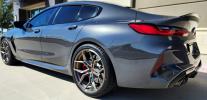|
"Salud"
Drives: M8 Gran Coupe Comp & X5M Comp
Join Date: May 2013
Location: The Burbs - N TX
|
 2018 Lamborghini Aventador S Lp740-4!
2018 Lamborghini Aventador S Lp740-4!
Still the iconic "Poster Car"...
Love the subtle changes and dare I say the most gorgeous factory wheels I have ever seen on a Exotic! This Silver-White metallic paint is perfect!
Quote:
The Aventador Sí improved handling is primarily a result of a rear steering system that can turn the rear wheels up to 1.5 degrees in-phase with the front wheels for better high-speed cornering or up to three degrees opposite the front wheels for better low-speed cornering. Lamborghini claims this has the same effect as lengthening the wheelbase 28.6 inches at high speeds for better stability or shortening it 19.7 inches at low speeds to improve the turning circle. In either direction, the wheels adjust in 5 milliseconds, so quickly as to be completely imperceptible. The system works at all speeds right up to the carís 218-plus mph drag-limited top speed.
To show off the improvement, Lamborghini arranged a simple slalom test pitting the outgoing Aventador against the new Aventador S. The difference is palpable. With rear steer and a quicker steering ratio, the S changes direction much more willingly and with less effort. The effect is most greatly felt in the rear end, which feels heavy and intractable on the old car. On the new car, the weight behind the driver transfers much more quickly, It feels like the rear end is working with the front rather than being dragged along around the corner. On the whole, the system has the effect of making the rear end feel hundreds of pounds lighter, despite the fact it weighs exactly the same. The roughly 13 pounds added by the rear steer hardware has been canceled by a new exhaust system that saves roughly the same amount of weight and sounds better. A standard, U.S.-spec Aventador weighs about 4,100 pounds.
Other improvements to the carís behavior come from a revised aerodynamic package, which features a more aggressive front splitter, better control of airflow around the sides and beneath the car, and an active rear wing with three positions. In total, they improve downforce by a claimed 130 percent. Lamborghini also says it has improved the trade-off between drag and downforce by 50 percent. Also on the docket: an extra 40 horsepower for a total of 730 hp on the American scale with all of it on the top end, magnetorheological dampers with new software, new rear tires with stiffer sidewalls designed to withstand the additional forces generated by the rear steer, new all-wheel-drive calibration software, and new software for the seven-speed, single-clutch, automated manual transmission,. Thereís also an EGO (yes, seriously) driving mode, which gives you the long overdue ability to make individual changes to the steering, dampers, and powertrain rather than stick to the three preset modes of Strada (street), Sport, and Corsa (race).
The Aventador S is also remarkably composed over bumps and curbing. The upgrade to magnetorheological shocks is a welcome one because even in Corsa mode they soak up bumps nicely and keep the chassis settled and planted to the ground.
The weak point remains with the transmission. As refined as Lamborghini has been able to get it, the compromise inherent to a single-clutch automated manual remains. Shifts are comparatively slow and clunky, exacerbated by the incredible acceleration gís before and after the shift. The new software is an improvement, but itís still nothing like a Huracan or any dual-clutch-equipped competitor (Lamborghini says there simply isnít enough room to package a dual-clutch transmission with the engine pointed backwards and the transmission between the seats). As a result, upshifts still induce a big shunt, though itís no longer the shovel to the back of the head it used to be. Upshifting while exiting a corner feels as though it could unbalance the car, though it never did. Coming completely off the throttle at high RPM also introduces a shunt as it would in a high-powered manual transmission car, though itís been mitigated somewhat by transferring engine torque forward to reduce dive.
Processing all these nuances at once requires practice. The Aventador S remains a wickedly quick car. The accelerative capability of that screaming V-12, which sounds as good as ever and spits fire constantly from the tailpipes under full throttle, is enough to make even power-jaded supercar drivers widen their eyes. Corners arrive in an instant, and with the car firmly against trail braking, getting your braking point right is critical. The big carbon-ceramics seem to lose their initial bite as they heat up, and the pedal gets a little longer. That being said total braking force doesnít diminish, and the pedal is easy to modulate. The weight transfer also takes a little getting used to. It happens quickly and can fool you into thinking the carís going to get loose when it actually has plenty of grip left. Once in the corner, itís best to have adopted a race car-like reclined seating position because the low windshield header can make looking through some corners difficult if you sit upright.
Itís no exaggeration to say the Aventador S is much better on the track than the original Aventador. As you might expect, itís not as capable or easy to drive at race speeds as the hardcore Aventador SV, but itís a big step in the right direction. Whatís it like on the street, though? Itís largely improved there as well.
Youíll find a much nicer car to live with day to day. The adaptive magnetorheological shocks are a godsend, enormously improving ride quality and reducing interior noise. The transmission shifts more smoothly than before, though itís still with a frustrating shunt. Itís slow, lazy, and left to its own devices in Strada mode, so Iíd recommend flicking those wonderful paddles at your fingertips or at least setting it to Sport. The quicker front ratio and rear steering help the big car feel much more nimble, though no smaller, on a tight canyon road. Again, seating position matters because it can be difficult to look through corners, and the seatís lowest vertical position isnít that low. Lay it back.
Unfortunately, I cannot give a full account of the Aventador Sí on-road performance capability because it began to rain just as we set off on our road drive. Despite Pirelliís assurance that wet weather performance is improved on these specially designed PZero tires, even moderately aggressive driving on wet roads would induce understeer or oversteer and bring on the stability control.
http://www.motortrend.com/cars/lambo...-drive-review/
|
|






